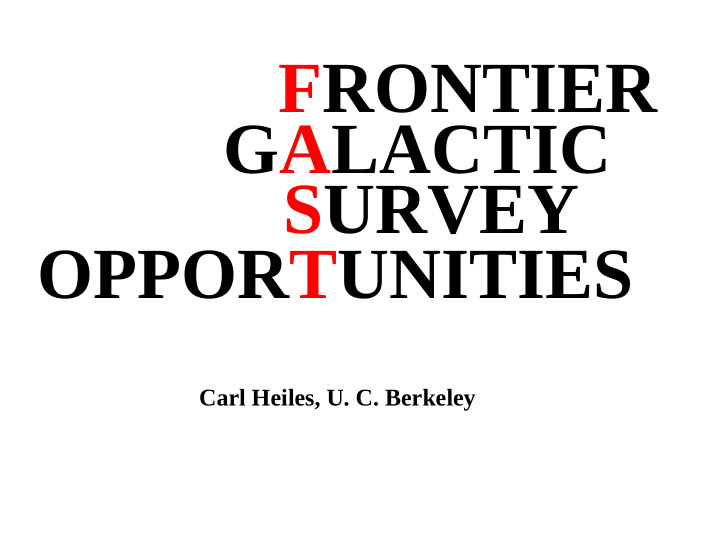



FRONTIER GALACTIC SURVEY OPPORTUNITIES Carl Heiles, U. C. Berkeley
FAST published telescope capabilities: > 19 feed multibeam. 1.05-1.45 GHz > ZA coverage to 40 degrees > HA coverage to +/- 3 hr > Continuous frequency coverage 70 MHz to 3 GHz > Multiple backends for commensal observing
WHAT THE ISM NEEDS FROM FAST: 1. Repeat the GALFA 21-cm emission line survey, INCLUDING all four OH lines. 2. Repeat the Millennium 21-cm absorption/emission line survey, covering all sources with S ~> 1 Jy. 3. Survey the linear polarization of the Diffuse Galactic Synchrotron radiation from ~100 MHz to ~1500 MHz and perform Faraday synthesis.
GALFA SURVEY Repeat the Arecibo GALFA survey, which covered the whole 13000 sq deg Arecibo sky with 3.4 arcmin resolutionl. (The Astronomical public has downloaded > 1227 standard GALFA data cubes (8 by 8 deg)). GALFA are unique because: They have the sensitivity of a single dish They have the angular resolution of interferometric surveys. And this probe into new parameter space has discovered NEW STUFF!
GALFA finds long, straight HI FILAMENTS!
The HI Fibers are aligned with the Interstellar Magnetic Field as Revealed by the Polarization of Starlight by Aligned Dust!
GALFA FINDS HI BLOBS
(Ap J, In press)
Both small and weak!
Arecibo (GALFA) map of the Knapp ultrathin sheet (aka the ‘Local Leo Cold Cloud’, or LLCC.
Basic properties of the LLCC: 1.Distance between 8 and 20 pc 2.Temperature ~ 18 K 3.Pressure ~ 60000 cm -3 K (Meyer et al 2012) 4.Overpressured by > 10 wrt local ISM WIM clouds (Redfield/Linsky) 5.Paper-thin. Aspect ratio ~ 1000:1 6.Most emission profiles are double-peaked and indicate (but not infallibly) two components approaching at ~ 0.7 km/s
HI and OH emission/absorption against continuum sources is very important in telling us physical conditions in the diffuse ISM. The Heiles/Troland Arecibo Millennium Survey is an important example---but we need a much bigger sample to firm up our conclusions! For example, in our Millennium survey, the number of actual Zeeman-splitting detections is…pitifully small.
Illuminating “Dark Gas” (Translucent gas) with OH...
From Science, 307, 1292 (2005) The mass of Dark Gas is comparable to that of H 2 as revealed by CO! In the Solar vicinity, HI and H 2 have comparable mass, so Dark Gas increases the total gas mass by 50%!
Top is Dark Gas from IRAS: [ IRAS – (HI + X*CO) ] Bottom is Dark Gas from [ EGRET gamma rays – (HI + X*CO) ] (Recall that gamma rays are produced by [ CR/H-nuclei ] interaction)
1996! This classic, but underappreciated, work pioneered the way towards Dark Gas.
Dark Gas studies continue “apace”. In 2012, work by > Cotton, Magnani et al (2012) > Allen (2012) shows that the Dark Gas is ubiquitous!
FARADAY ROTATION The Faraday Rotation Measure (RM) is RM = 0.81 ∫ n e B los ds rad m -2 It is the easiest magnetic field tracer to measure---by far. First, let’s consider the Galactic Faraday Rotation of EXTRAGALACTIC SOURCES (usually, Galactic RMs dominate those that are intrinsic to the source itself).
Taylor, Stil, Sumsrum (2009) derived ‘best guess’ RMs for all 37,543 NVSS sources. Most of these RMs are correct. They allow a detailed mapping of RM on the sky. This is a MAJOR ADVANCE. To understand this, we first look at the RM distribution given by Oren & Wolfe (1995)—for 499 sources…
HI: 21-cm line (LAB) Faraday RMs (Taylor, Stil, Sumsrum 2009) H+: H-alpha line (WHAM)
Assumed Distance= 200 pc n(e) = 0.10 cm -3 78 pc 2n(e)T=1650 cm -3 K B=7.6 µG P=16400 cm -3 K 117 pc NCP 88 pc z=116 pc n(e) ~ (1/Assumed Dist) B ~ (1/Assumed Dist)
Now, let’s consider the Diffuse Galactic Synchrotron Polarization > We can map the polarization and Faraday Rotation > But these maps are tricky: -You need to consider the ‘Faraday Depth’. - Interferometric maps are spatially filtered, providing only the small scales. Stokes parameters, polarization position angle, and polarized intensity suffer severe distortions without the “zero-spacing” data. - Single dishes miss the small scales.
When you map an area like this, you don’t get a map of polarized emission; rather, you get a data cube, in which the polarized emissivity is a function of (α, δ, φ).
The application, and in particular the interpretation, of F(φ) spectra derived from Faraday Rotation Synthesis is in its infancy. Applying Faraday Rotation Synthesis requires good coverage and sampling in frequency space---just as applying standard Aperture Synthesis requires good (uv) coverage. The Galaxy has RMs ranging up to a few hundred (sometimes more). One needs to cover roughly 100 MHz to 1500 MHz…or more.
WHAT THE ISM NEEDS FROM FAST: Repeat the GALFA 21-cm emission line FIN survey, INCLUDING all four OH lines. Repeat the Millennium 21-cm absorption/emission line survey, covering all sources with S ~> 1 Jy. Survey the linear polarization of the Diffuse Galactic Synchrotron radiation from ~100 MHz to ~1500 MHz and perform Faraday synthesis.
Fin
Recommend
More recommend